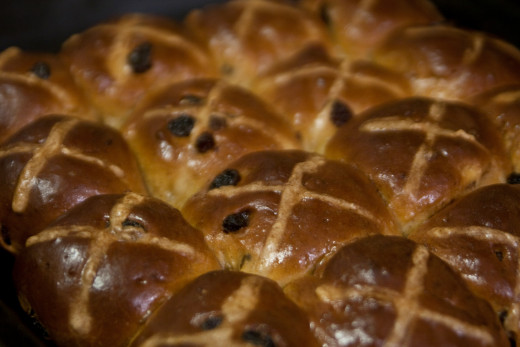Hot Cross Buns - What, When and Why?
What is a Hot Cross Bun?
A hot cross bun is a fruit bun baked with spices, currants and raisins and marked with a cross on top. In the UK it is traditionally for sale during Lent, the period before Easter.
Oxford Online Dictionary defines a hot cross bun as
'A bun marked with a cross and containing dried fruit, traditionally eaten on Good Friday'

What is Lent?
Lent is a time in the Christian Church that occurs before Easter. It usually last for 40 week days and is a time for fasting, in recognition of Christ's fasting in tne wilderness.
Why are they Baked at Easter Time?
Historically there are references to the buns being called Good Friday Buns, one of these being Samuel Pepys in his diary of 1666.Where the tradition of eating these buns at Easter came from is less clear, although there are historical references to Elizabeth I and her banning of these buns at non festival times.
Hot Cross Buns Rhyme
Growing up in the UK it is hard to avoid the rhyme Hot Cross Buns. Along with all the usual rhymes young children sing, Hot Cross Buns is a popular clapping song. But very little is known about the origin of the song. One of the earliest written references to the song is in Poor Robins Almanack of 1733.
The Oxford Dictionary of Nursery Rhymes records this version as
' Hot cross buns!
Hot cross buns!
One a penny, two a penny.
Hot cross buns!
If your daughters do not like them
Give them to your sons;
But it if you haven't any of these pretty elves
You cannot do better than eat them yourselves.'
It is thought that the rhyme comes from the street sellers and hawkers who sold the buns, calling to their customers. 'One a penny, two a penny, refers to the size of the buns. Small buns were sold two for a penny, the larger ones for a penny each.
Origins of Hot Cross Buns
There are several different thoughts on the origins of hot cross buns.
Time Period
| Custom
|
|---|---|
Ancient Greece
| At the annual Spring festival small sweet cakes made from flour and honey were offered to the gods. these buns were believed to be marked with a cross.
|
Saxon
| Ancient Saxons worshipped the God Eostre. buns with crosses on we're baked in honor of Eostre. It is thought that the cross on the buns represented the four quarters of the cycle of the moon.
|
Medieval England
| During this time hot cross buns were only permitted to be sold during special occasions such as Christmas, Easter and Funerals.
|
Other Origins of the Crossed Bun
Fino Rohrer in his BBC News Magazine article offers several possible sources for the origins of the hot cross bun. Including Roman, Greek and Pagan origins, one suggestion is that a 12th century monk was the first to make a cross on a bun, another is a 14th century monk at St Albans. He also highlights the movement against the buns during the Elizabethan era when the Protestant movement restricted the production of these buns to festivals and funerals.
Customs/Traditions Relating to Hot Cross Buns.
There are several customs or traditions surrounding hot cross buns. One tradition is to hang some buns from the ceiling for the whole year to ward off evil spirits. Another is to use the gratings from a preserved bun to cure a cold by mixing it with water.
A pub called The Widow's Son at 75 Devonshire Road in Bow in tne East End of London is believed to have been built on the site of an old widows cottage. Every year on Good Friday, the tradition of the Widow’s Buns is celebrated. The legend is that the old widow's only son left to go to sea, and wrote to her that he would be returning home at Easter and to have a hot cross bun waiting for him. He never returned, but his mother continued to keep a fresh hot cross bun every Good Friday for the rest of her life. After her death, a huge collection of hot cross buns was discovered in a net hanging from the ceiling of her cottage. Each year a sailor places an new bun in tne net hung in the pub.
From the mid-18th century, Good Friday buns were believed to have medicinal or curative properties. They were hardened over the months or years, and grated into food to help digestive or bowel problems.
It is believed that buns cooked on Good Friday would never go mouldy.
They were hung up as a good luck charm.

Hot cross bun mix

The Addition of the Cross
There are many theories about the placing of the cross on the buns. One suggestion is that it is a Pagan symbol, represnting the four elements. Another theory is that it represents the four quarters of the moon. The Christian symbolism of the cross is why the buns are eaten on Good Friday today.
It is believed that historically the cross were marked with a knife cut whereas today it is piped on with icing or dough.
Do You Like Hot Cross Buns Toasted?
Recipe for Hot Cross Buns
Many people bake their own Hot cross Buns and have their own twist on the ingredients they use, often passed down through families.
How to Make Hot Cross Buns
Modern Twists on Hot Cross Buns
Increasingly many supermarkets and department stores in the UK have their own twist on tne modern recipe. Double Chocolate, Apple and Cinnamon, Fudge and Belgian Chocolate and Cranberry and Rasin are just a few of the flavors being manufactured.
So whether you eat buns because you are ending Lent, as an Easter treat or any other reason enjoy them toasted and buttered!









